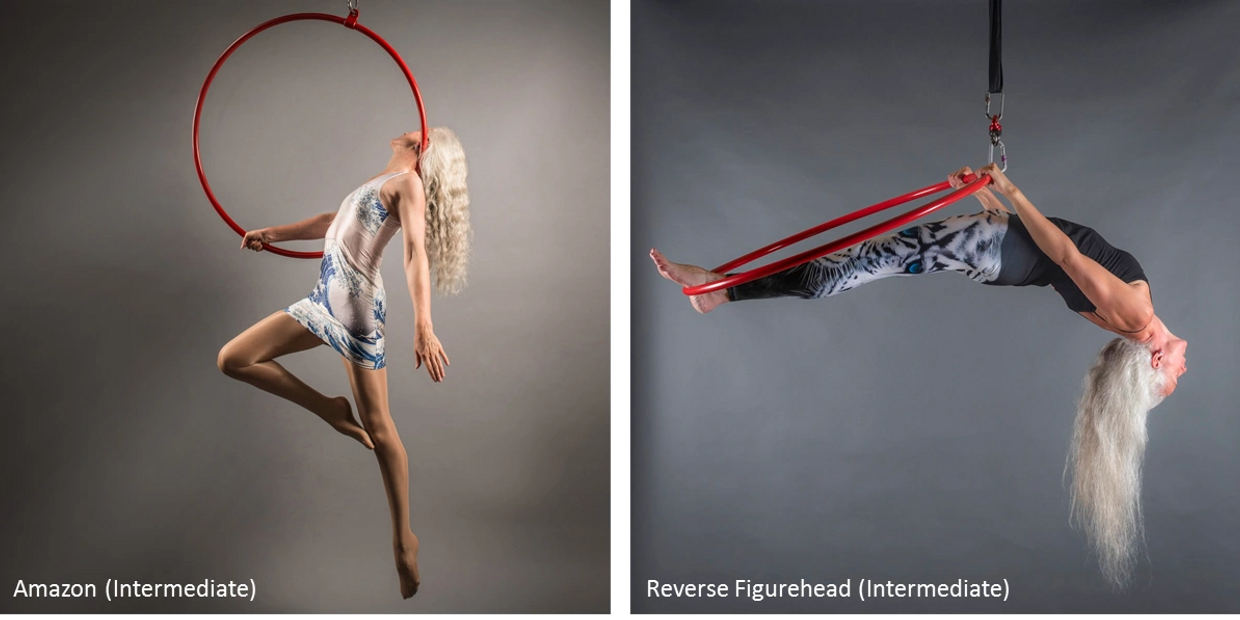Hoop makes you strong - on the inside
CORE HOOP: INTERMEDIATE
Onwards and upwards
In intermediate hoop moves, more strength is required than for beginner moves: strength in the back, chest, shoulders, core, arms, legs, ankles, feet. Almost everywhere, in fact. Some moves also start to explore your flexibility, but don't worry, we do lots of stretching in the beginner classes, so you will be well prepared by now. Many intermediate moves also explore the top bar of the hoop. And you will also learn how to transition between moves so that you can perform long sequences that will greatly improve your stamina and, as a result, your movement control.
Keep reading to find out how intermediate moves build your core, your overall strength, your stretchiness and your stamina.


Intermediate Moves: Core
Engage those abdominals
Many intermediate moves build core strength, which is the ability to fold, unfold, or hold your torso in tension working against gravity. This is different from core stability, which is the ability to stiffen the torso and resist movement. (Beginner moves Seat and Man In The Moon develop core stability, for example.) The ability to tuck the body up into an inverted position (legs over head) is a fundamental intermediate-level transition that is used a great deal.
Front Balance and Ankle Hang are good examples of moves that require a lot of tension in the core muscles and so build core strength. Ankle Hang looks as though all the effort and tension is in the legs, but if I relaxed my core muscles, I would drop out of the hoop.

Intermediate Moves: Strength
Muscling in
When you start doing intermediate hoop moves, you will probably already be able to pull up your own body by your arms. Maybe only a short distance to start with, maybe only once before tiring, but it will happen. This pulling action is supported by muscle groups in the shoulders, back, and front torso, and is necessary for you to be able to safely do many intermediate moves without damaging yourself through bad technique.
Two intermediate moves that require considerable strength are Amazon (side) and Reverse Figurehead. Amazon (side) looks easy, but there is a great deal of tension hiding in that right arm. Reverse Figurehead requires strength to make sure the feet stay glued to the bottom bar, to keep the whole body held in tension, and to support the body's weight with the arms. (I should add for safety that I should be standing on the balls of my feet, not the arches.)

Intermediate Moves: Stretch
Flexible working
As well as a source of infinite fun, the hoop could be viewed as a stretching aid, if you like. On a hoop you can get yourself into all sorts of positions that would be impossible on the ground, and that enable you to explore your flexibility in new and challenging ways.
These two photos of a Shoulder Stand Single Hocks variation were taken 16 months apart. In the left-hand, earlier photo my hand could only just reach the toes of my foot. Now (another two years after the later, right-hand photo) I can kiss my knee. And what I find really interesting about this is that my hamstring muscles have not got slacker or longer over these years. The difference is in the fact that my brain has been persuaded and is now allowing my knee to get close enough for me to kiss it. Marvels of the neuromuscular system!
As in many kinds of dance, in aerial hoop there is a bit of an emphasis on the splits. But fear not, you don't have to be able to do the splits when you start aerial hoop—or even four years after you start aerial hoop. I can almost do front splits now, but my thighs are still not completely flat to the ground. Your flexibility will improve as a matter of course from doing hoop and the stretching exercises that we do at the end of hoop classes, so don't worry about the splits or any other stretches.

Intermediate Moves: Stamina
Aerial fitness
Although this page talks about single hoop moves, the aim in aerial hoop is not to just do a single move in isolation, but to perform sequences of moves that are glued together with what we call 'transitions'. Performing a handful of moves without a break, or even long sequences of 20 or 30 moves that last two or three minutes, builds stamina as well as strength.
When you first start to practise longer sequences, you get worn out very quickly and have to rest between moves. But things soon improve, because the body adapts to the hoop training you are doing, and becomes stronger and fitter. And as your stamina grows, you find that the degree of control you have for each individual move also grows, which brings even harder moves within your grasp. A very happy outcome.
An example transition is from Cradle (beginner) to Wineglass (intermediate). From Cradle you unfold your top leg and drop the foot, while extending your other leg upwards keeping it behind the hoop, and moving the opposite arm and shoulder behind the hoop. So now you know!
Aerial hoop is an unusual combination of isotonic and isometric exercises. Isotonic exercises involve movement, while in isometric exercises the body remains still while the muscles work to maintain tension. Getting into and out of hoop moves, and transitioning between them, is isotonic work, while pausing to hold most hoop moves for a few seconds is isometric work. Both these kinds of exercise are very beneficial. I am struggling to think of another activity that emphasises both these types of exercises as much as hoop does.